
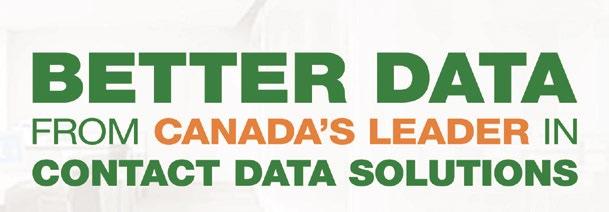
data-driven is complicated. We can help. VOL. 36 • NO. 1 • JANUARY 2023 THE AUTHORITY FOR THE DATA-DRIVEN BUSINESS PM40050803 ❱ 9 The Agency/ In-House Pendulum Swings Again ❱ 16 Fulfillment and AI 8 Predictions for the Year Ahead
Being
We’ll Help You Keep It Clean

Melissa.com 800.MELISSA (635-4772) Trust the Address Experts to deliver high-quality address veri cation, identity resolution, and data hygiene solutions.
Dealing with bad data is a task no marketer needs on their checklist. Inaccurate, outdated, and duplicate records can build up in your database, affecting business decisions, the customer experience, and your bottom line.
Address Experts, Melissa helps our customers improve their direct marketing efforts with the best Address Veri cation, Identity Veri cation and Data Enrichment solutions available. We validated 30
records
which is why thousands of businesses worldwide have trusted us
their data quality
Contact us for a Free Proof of Concept and ask about our 120-day ROI Guarantee. BAD DATA BUILDUP Missed Opportunities Returned Mail & Packages Decreased Customer Insight Real-time Address Veri cation Change of Address/NCOA Processing Geographic & Demographic Data Appends DATA CLEANLINESS
As the
billion
last year alone,
with
needs for 37+ years.
PRESIDENT Publisher & Editor-in-Chief
Steve Lloyd - steve@dmn.ca
ASSOCIATE EDITOR


















Michael Brooke - michael@lloydmedia.ca
Jennifer O’Neill - jennifer@dmn.ca ADVERTISING
Steve Lloyd - steve@dmn.ca

302-137 Main Street North Markham ON L3P 1Y2
Phone: 905.201.6600 Fax: 905.201.6601 • Toll-free: 800.668.1838 home@dmn.ca • www.dmn.ca

EDITORIAL CONTACT:



DM Magazine is published monthly by Lloydmedia Inc. DM Magazine may be obtained through paid subscription. Rates: Canada 1 year (12 issues $48) 2 years (24 issues $70) U.S. 1 year (12 issues $60) 2 years (24 issues $100)

DM Magazine is an independently-produced publication not affiliated in any way with any association or organized group nor with any publication produced either in Canada or the United States. Unsolicited manuscripts are welcome. However unused manuscripts will not be returned unless accompanied by sufficient postage. Occasionally DM Magazine provides its subscriber mailing list to other companies whose product or service may be of value to readers. If you do not want to receive information this way simply send your subscriber mailing label with this notice to:
Lloydmedia Inc. 302-137 Main Street North Markham ON L3P 1Y2 Canada.





// 3 JANUARY 2023 DMN.CA ❰ Vol. 36 | No. 1 | January 2023
DESIGN / PRODUCTION
SALES
John Tschohl
Insights Steve Zisk
INC. HEAD OFFICE / SUBSCRIPTIONS / PRODUCTION:
CONTRIBUTING WRITERS Leendert De Voogd Conner Galway Steve Levy Camela Thompson
360
LLOYDMEDIA
Canada Post Canadian Publications Mail Sales Product Agreement No.
Twitter: @DMNewsCanada LEADERSHIP INSIGHT NEXT ISSUE: A look to the future of loyalty programmes TECHNOLOGY ❯ 8 The Agency In-House Pendulum Swings Again ❯ 10 3 Ways Data-Driven Marketers Will Prevail in 2023 ❯ 17 Should You Build or Buy a Channel Incentives Platform? ❯ 18 The Myths and Realities of Social Intelligence and Analytics STRATEGY ❯ 4 Talking Points talkingpoints ❯ 14 ShopThing Refines The Omnichannel Experience ❯ 16 How AI is Revolutionizing the Fulfillment Process ❯ 20 A Double Take: Digital Twins and Customer Experience ❯ 22 Recognition is Critical 8 Predictions for the Year Ahead ON THE COVER ❯ 11 8 Predictions For the Year Ahead ISTOCK/ NADEZHDA BURAVLEVA COURTESY SHOPTHING COURTESY SHIPBOB COURTESY KALHH COURTESY 360INSIGHTS ISTOCK/ SERRNOVIK ISTOCK/ FEODORA CHIOSEA
POSTMASTER: Please send all address changes and return all undeliverable copies to: Lloydmedia Inc. 302-137 Main Street North Markham ON L3P 1Y2 Canada
40050803
talkingpoints
or add a single page of content on a specific topic. Over time, we see Tome’s AI becoming increasingly nuanced – refining tone, honing the perfect visual to express a point, or creating alternative layouts and charts.”
Tome’s AI works iteratively with creators to create compelling presentations and stories. Creators can input a simply written prompt and instantly generate a full narrative structure. Additional iterations and new AI functionality, including text and tone editing, inline image adjustments, and alternate layouts, are expected in early
“As AI crosses over from the research lab into applications for day-to-day life, a new wave of innovators stand to reshape every part of our world,” said Dan Rose, board member at Tome, and Chairman, Coatue Ventures. “It is particularly exciting to support teams like Tome who are building AI-enabled storytelling tools that have the potential to transform how we communicate ideas. We believe these are the types of tools that will define the next decade of innovation in technology.”
Generative storytelling builds on Tome’s existing AI functionality, which includes its DALL·E 2 image generation tile, automated colour picking and responsive design system. Tome is also equipped with numerous integrations that let creators tell stories with any type of content, from interactive prototypes and 3D renderings to live integrations with popular tools, such as Figma, Airtable, Framer, Looker, and Giphy.

Tome can be accessed via desktop or Tome’s iOS app. Use generative storytelling to cocreate your next presentation by creating a free Tome account at tome.app.

Tome





















AI to Work With First-Ever Generative Storytelling Tool
Anyone can turn ideas into complete and visually-compelling narratives with a single prompt using Tome. It’s an AI-powered storytelling format for work and important ideas. Launching in beta, Tome’s AI enables creators to generate entire narratives from scratch, complete with intelligent titles, outlines, pagination, page layouts and page content supported by GPT-3 and AIgenerated images.
“Generative text and image technology has captivated the world, but we’ve yet to see an application that can power a compelling, visually-engaging story. We’re putting this technology to work in a really tangible way that helps anyone express themselves or share important ideas. Now creators can generate complete, visual narratives with a single written command,” said Keith Peiris, Tome cofounder and CEO. “Gone are the days of writer’s block or staring at a blank page. Unlocking your best work and ideas in Tome is now as simple as typing a prompt and hitting enter.”
“We think about AI as a collaborative partner that you can iterate with and create with,” said Henri Liriani, Tome co-founder and CPO. “Our vision is that AI is available when you’d like it, at any stage of the creation process. Now, for example, you can use AI in Tome to riff on an idea, create a starting point with visuals,
2023. Creators can use Tome’s AI for endless work applications, including building presentations, product roadmaps, fundraising decks, sales pitches, thought leadership pieces and more. Creators can also use Tome’s AI for creative applications in their personal lives, from generating an itinerary for their next trip to making a visual how-to fitness guide to crafting a new bedtime story for their child every night.
“We’re entering an era of human amplification where we’ll see a historic acceleration in the coupling of human intelligence and technology,” said Reid Hoffman, board member at Tome and OpenAI, and Partner at Greylock. “Tome is a compelling proof point and window into a future where AI-powered tools enhance human creativity, as well as everyday tasks and critical problem-solving. This shift will make professionals and companies more productive and inventive in every industry.”
CITIZEN debuts CZ smartwatch with proprietary wellness software that anticipates learns, and gets smarter with the wearer.
The company recently announced its newest version of CZ Smart, the Smarter Smartwatch. The revolutionary wearable provides a builtin self-care advisor through the proprietary CZ Smart YouQ application, developed using research pioneered by NASA’s Ames Research Center and AI built through CITIZEN partnerships using the environment and tools within IBM Watson® Studio on IBM Cloud.

The CZ Smart YouQ software helps the wearer understand and anticipate patterns of fatigue and alertness and offers customized insights and personalized strategies to build better habits to maximize a wearer’s daily potential. CZ Smart watches combine timeless watch design, purposeful function, and innovative technology in a game-changing wearable device.
The CZ Smart YouQ application provides insights that help make the wearer smarter about their own wellness, syncs with their daily life, and provides real-time biofeedback.


// 4 ❱ DMN.CA JANUARY 2023
Puts
■ ■ ■ ■ ■ ■ ■ ■ ■ ■ ■ ■ ■ ■ ■ ■ ■ ■
Using neural networks developed within the IBM Watson® Studio workspace, CZ Smart YouQ can learn and understand the wearer’s chronotype (an individual’s preferred timing of sleep and wake) within seven to ten days by processing their sleep data and Alert Scores and deepens that understanding over time. Alert Scores are generated when a wearer takes a custom-designed Alert Monitor test, a consumer-facing iteration of NASA’s Psychomotor Vigilance Task Test (PVT+), originally developed to determine the mental acuity of astronauts. The CZ Smart YouQ Alert Monitor was designed based on NASA’s PVT+ test and utilizing research from leading science and academic experts at NASA’s Ames Research Center Fatigue Countermeasures Laboratory. The Alert Monitor tests are brief, gamified, and can be taken daily to measure the wearer’s alertness.
Through personal data points captured with the watch, including Alert Scores, chronotype, sleep patterns, activity, and heart rate monitoring, CZ Smart YouQ quantitatively analyzes and learns about the wearer’s unique characterization, rhythms, and habits to enhance the personalization. By utilizing a dynamic recognition model to match wearers to their chronotype, the CZ Smart YouQ application recommends highly personalized Power Fixes, suggested actions to help the wearer mitigate the effects of fatigue, improve alertness, and promote the building of better habits, readying the wearer to meet whatever the day may bring.
Over time, aggregating wearer data will enable CZ Smart YouQ to cater to wearers more personally; not just in understanding them, and their relationship to chronotypes, but also in understanding the effectiveness of certain Power Fixes for each person.
“What is the Holy Grail of contactless blood pressure measurement? It’s when you can measure your blood pressure with an accuracy corresponding to a standard deviation of error of less than 8mmHg,” stated NuraLogix CEO and cofounder Marzio Pozzuoli. “This represents a breakthrough achievement by the research team at NuraLogix and sets a new industry benchmark.” Even more importantly this level of accuracy was achieved without physiological calibration of the measuring device (i.e. Anura) to the individual having their blood pressure measured.
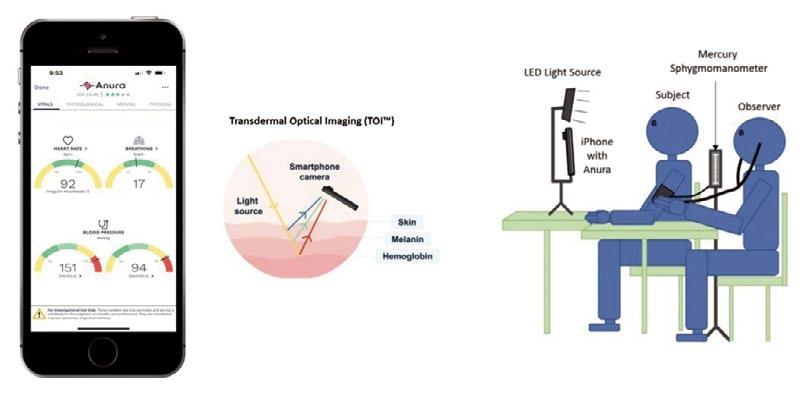
Previously in 2020, NuraLogix was the first to achieve this level of accuracy for contactless video camera-based BP devices with N=85 subjects which is the minimum requirement according to ISO 81060-2:2018 the standard used by all BP devices to measure accuracy. The current testing was done on N=554 subjects which represents a new benchmark and that the technology is more generalizable to a broader population.
conversation and display subtitles from several different languages in real time. Instant calls and message notifications pop up timely. TCL RayNeo X2 serves as your daily smart assistant in work and life.
NuraLogix announces ‘Holy Grail’ of blood pressure measurement.
Toronto-based NuraLogix is the creator of the world’s first contactless blood pressure measurement technology. The company’s patented technology can measure 30+ health and wellness parameters using Transdermal Optical Imaging (TOI™), a patented technique developed by the company in which a conventional video camera is used to extract facial blood flow information from the human face. This is demonstrated in the company’s ground-breaking apps Anura™ and Anura Lite™.
TCL takes a major step forward in augmented reality in 2023 with the launch of its next-generation AR glasses.
The TCL RayNeo X2 are smart wearable glasses and are the next step into the future display experiences
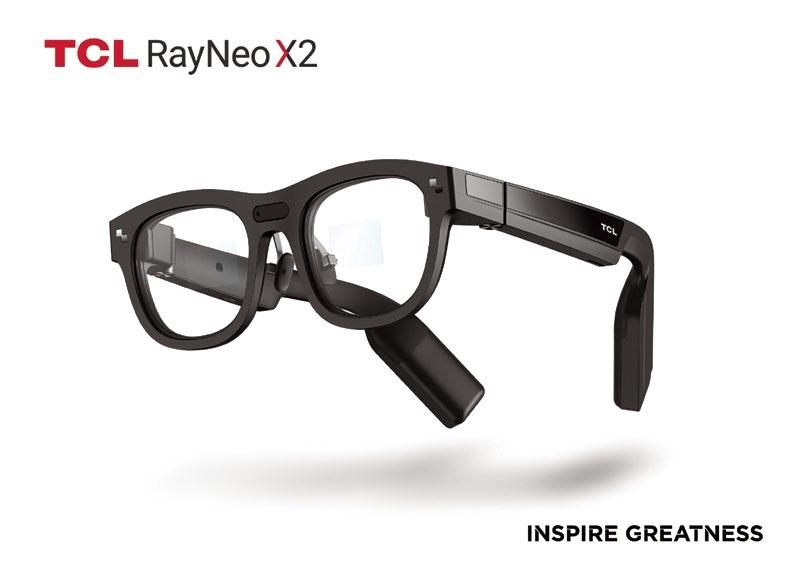
Taking the industry lead to implement the groundbreaking display technology of binocular full-colour Micro-LED optical waveguide display, TCL RayNeo X2 serves various functions like smart navigation, autotranslation, photography, filming and musicplaying in a regular glasses design. Major display upgrades of a high contrast ratio of 100,000:1 as well as image brightness of up to 1000 nits make it ideal for both indoor and outdoor usage.
Powered by the Qualcomm Snapdragon® XR2 platform, TCL RayNeo X2 features simultaneous localization and mapping (SLAM) and gesture recognition interaction. This device is a traveller’s dream. Its powerful mapping technology shows nearby landmarks and its integrated advanced AI translation system breaks down language barriers. TCL RayNeo X2 can translate the
TCL NXTWEAR S wearable display glasses feature an equivalent 130-inch, highdefinition screen at four meters away, newgeneration dual 1080p Micro OLED displays, and a unique acoustic phase cancellation mode, TCL NXTWEAR S offers a cinematic audiovisual experience anywhere, anytime.
TCL takes a bold step in bringing virtual reality experiences to market with the NXTWEAR V virtual reality concept. With only 236g, the light and comfortable wear, enables users to forget which reality they are in as they experience realistic colour performance and interactivity. The display, developed by TCL CSOT, produces a realistic colour performance thanks to the VR optical module providing 108-degrees field of view and 1512ppi pixel density, improving both picture quality and relief from dizziness. Whether discovering the metaverse, playing immersive games, or learning new skills, TCL NXTWEAR V captivates users in a world they will want to explore for hours.

WeBranding Debuts AI-Powered Digital Marketing Platform for Global
Brands
WeBranding Global announced in January the company’s newest version of Adtarg, an artificial intelligence (AI)-powered marketing platform. The company’s industryleading Customer Insight System (CIS) now includes Market Listening System (MLS) and Voice of the Customer (VoC), designed to improve customer experiences and enhance eCommerce marketing strategies for global brands.
Adtarg is a revolutionary SaaS platform powered by AI that is helping companies accelerate growth and compete in the global tech ecosystem. It captures and analyzes big data, provides curated customer insights, and accelerates innovation in customer engagement products and services designed to strengthen brand loyalty and improve customer satisfaction.
// 5 DMN.CA ❰ JANUARY 2023
■ ■ ■ ■ ■ ■ ■ ■ ■ ■ ■ ■ ■ ■ ■ ■ ■ ■
■ ■ ■ ■ ■ ■ ■ ■ ■ ■ ■ ■ ■ ■ ■ ■ ■ ■
■ ■ ■ ■ ■ ■ ■ ■ ■ ■ ■ ■ ■ ■ ■ ■ ■ ■
talkingpoints












personal relationships with customers across eCommerce platforms and improving product satisfaction and customer retention success. Adtarg helps businesses grow with the power of data, creating more unified experiences people love.”
Adtarg allows companies to better track and respond to customer patterns and insights across digital channels. Backed by machine learning and big data analytics, the SaaS digital marketing platform delivers customized, real-time customer expectation, experience, preference, and aversion data.











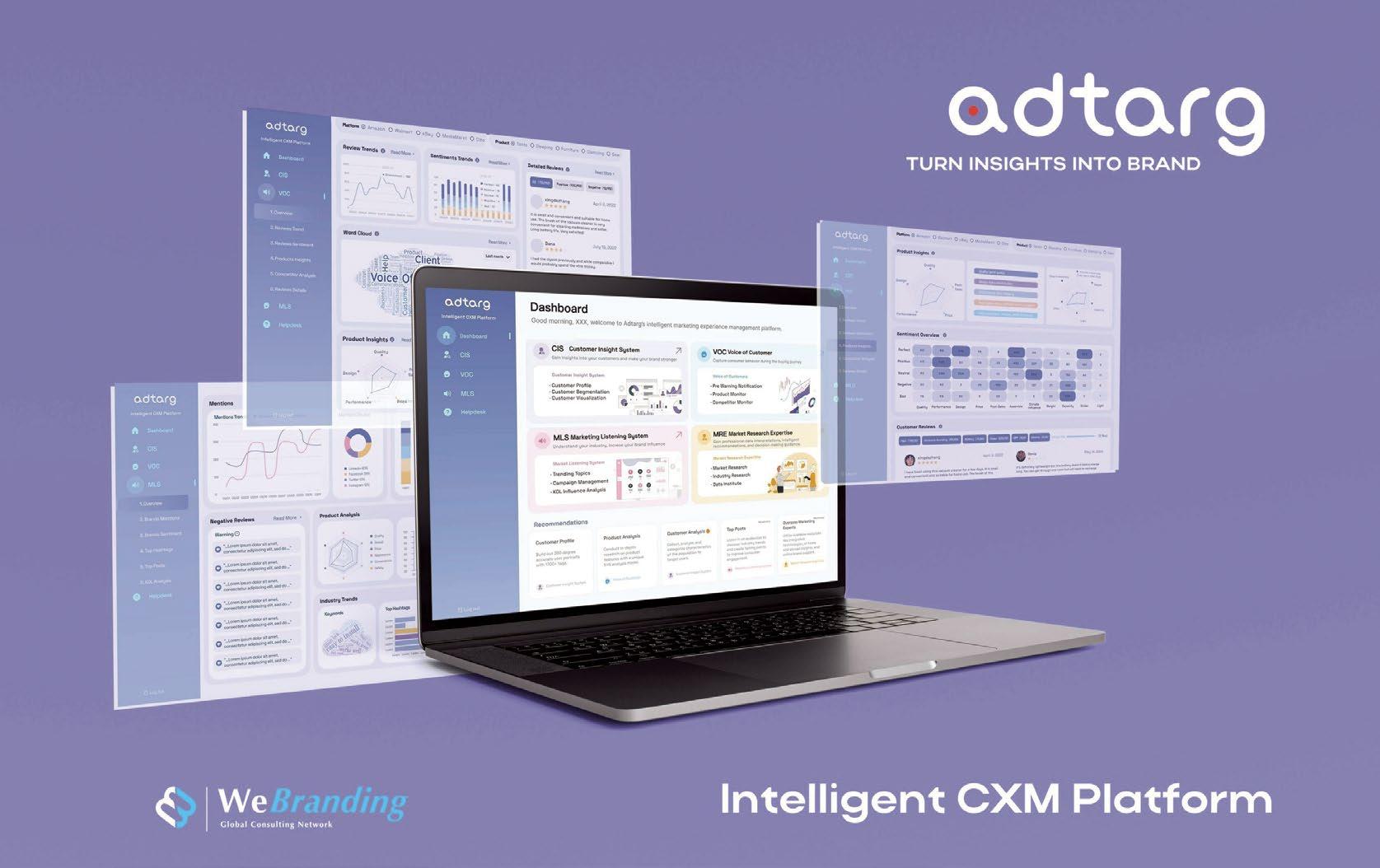
people to visit a clinic or a hospital for minor ailments or non-urgent care.
“Our new partnership with MedEssist moves us closer to our goal to help make Canada’s healthcare system more efficient by helping Canadians access the expanded services pharmacists in many parts of the country can now provide,” said Medimap CEO, Thomas Jankowski.
“We are excited to be able to offer this new feature to our users because it will help increase awareness about the important role pharmacists play in our healthcare system and help patients get timely access to care,” said Joella Almeida, MedEssist’s Co-Founder and CEO.
The strategic partnership will begin as a pilot project before a deeper system integration making it even easier for patients to find the care they need, when they need it.
WeBranding Global’s innovative digital marketing tool is designed for global brands and supports digital transformation while improving data-driven decision-making to enhance brand strategy and customer lifecycle management. Companies use Adtarg to uncover powerful data insights, strengthen brand loyalty, enhance product marketing results, and engage customers across global markets and digital platforms.
The platform’s 3-in-1 system not only improves social media monitoring in realtime, tracking brand mentions and delivering competitor analysis for a more comprehensive view of the digital marketplace but increases customer engagement with data-driven user profiles that improve marketing strategy. With Adtarg (AI)-powered marketing platform, brands can also improve data collection and analysis across eCommerce platforms, from Amazon to Walmart, to better manage customer feedback.
“Adtarg uses the latest AI-powered digital marketing and data analytics technologies to help brands stand out in the marketplace and solve the problems that come from serving customers around the world, across different cultures, time zones, and borders,” said Rebecca Ding, founder and CEO, WeBranding Global. “WeBranding Global is helping companies build stronger, more
With more customer-driven marketing plans, companies are improving brand development and shopping experiences online. Trusted by the world’s valuable brands, Adtarg delivers real-time data insights, drives innovation, identifies gaps in the market, and helps companies influence customer behaviors and strengthen brand loyalty across channels.
Medimap partners with MedEssist to make clinical pharmacy services more accessible to Canadians.
Medimap has signed a strategic partnership with a national digital health platform, to make clinical pharmacy services more accessible to Canadians.
Medimap already makes finding walkin clinics and other types of Health Care Practitioners easy to find thanks to its innovative digital platform. Its new partnership with MedEssist will now make it easier for people to book appointments with pharmacists and access the services they provide, thanks to MedEssist’s extensive relationships with pharmacies across Canada.
This strategic partnership will help Canadians utilize pharmacists’ expanding scope of practice and reduce the need for
Factor, a new clean eating, ready-to-heat meal delivery service arrives in Canada.

The service has been available in the US since 2012 and is the country’s largest ready-toheat meal brand*. Factor is now available across Ontario, with a national roll-out planned for the coming months.
Factor makes it easier than ever to make better mealtime choices, with chef-prepared, dietitian-approved meals delivered directly to your doorstep.
“This is convenience without compromise,” explains Conal Gould, General Manager, Factor Canada. “With Factor, made-fromscratch, chef-prepared meals are delivered fresh to your door every week - all you need to do is heat and eat.”
Expert chefs prepare every Factor meal from scratch, using only high-quality, fresh ingredients, including premium proteins raised without antibiotics, and all meals are free from refined sugar and oils. Every order is delivered fresh — never frozen — and is ready to heat in just minutes. Registered dietitians work hand-in-hand with the kitchen to ensure every meal is packed with premium, science-backed nutritional quality and every customer has the opportunity to participate in a complimentary 20-minute call with an in-house dietitian.
// 6 ❱ DMN.CA JANUARY 2023
■ ■ ■ ■ ■ ■ ■ ■ ■ ■ ■ ■ ■ ■ ■ ■ ■ ■
■ ■ ■ ■ ■ ■ ■ ■ ■ ■ ■ ■ ■ ■ ■ ■ ■ ■
Dishes like vegetarian Vegetable Ratatouille with Mascarpone Polenta, or a Keto JalapeñoLime-Cheddar Chicken with Spicy Cilantro Cauliflower Rice are specifically crafted to fit a wide variety of diets, including Calorie-Smart, Keto, Vegan and Vegetarian, to help anyone achieve their fitness, nutrition and lifestyle goals. New meal offerings are added weekly, plus, there are some easy-to-add tasty extras like cold-pressed juices.
“We get it,” continued Gould, “Canadians are busier than ever, and the time and energy it can take to plan and prepare healthy meals is often one of the first things to go. Factor has been specifically designed to help turn a hassle into a habit, effortlessly.”
Factor is brought to consumers by HelloFresh. With a market potential of $162 billion USD ($221 billion CAD) globally, the ready-to-heat segment is growing rapidly. To satisfy this global appetite, HelloFresh has not only acquired Factor in the US, but will be supporting the Canadian launch in Ontario. In the US, efforts are paying off: since being acquired by HelloFresh in November 2020, Factor has seen a compounded annual revenue growth of more than 100 percent.


Trend #1: Changing Consumer Health & Wellness Focus

Immune health has been a key focus since the onset of the COVID-19 pandemic, but recent surveys indicate other priorities are rising as well. In one survey of over 5,000 consumers from seven countries, the top concerns were sleep quality and stress, as well as brain health and function.
Trend #2: More People Are Set To Discover the Power of Protein Market data shows that the protein powder and amino acids segment is the fastestgrowing sector in the supplement category. It is not only the increasing number of sports enthusiasts and bodybuilders fueling this growth, but also consumers purchasing collagen protein products to help promote skin health and beauty from within. Dr. Murray notes that Collagen leads as the fastest-growing protein choice, with consumers also purchasing more and more vegan protein (pea, hemp, pumpkin, soy, rice, etc.) and whey, casein, and egg protein powders.
Trend #3: Non-Pill Forms of Supplements
Will Grow in Popularity
Traditional tablets and capsules will continue to be a top choice, but consumers are also increasingly looking to non-pill alternatives. According to Nutrition Business Journal, in 2021, more than 60 percent of the purchases of dietary supplements were non-pill forms like gummies, chews, powders & tablets, exceeding sales of pills for the first time. Within the article, Dr. Murray explains why gummy supplements, in particular, are at the head of this growth, and how we can expect them to continue to rise — with the most significant trend being the growth in vegan gummies specifically.
Trend #4: Mushroom Products Are Blooming
The global health mushroom market is estimated to be worth over $25 billion and is expected to grow over 10 percent yearly for the next eight years. This growth represents the significant increase in the popularity of functional mushrooms as both food and dietary supplements due to their numerous health benefits. Dr. Murray predicts that Chaga, Cordyceps and Turkey Tail will surge in popularity, in addition to well-known shiitake and reishi, and why within his trend forecast.
Trend #5: Sustainable Hydration Products Are Moving Upwards
Another emerging trend that Dr. Murray notes is the increase in the popularity of effervescent electrolyte mixes used to enhance water and promote hydration, which he cites in the blog as one of the fastestgrowing types of dietary supplements. These hydration products are available in both tablets and powdered drink mixes and serve as alternatives to ready-to-drink electrolyte hydration drinks in wasteful, single-use plastic bottles. Historically, athletes have used electrolyte drinks and supplements to help recover, and consumers across the board are now using them to seamlessly deliver functional ingredients as well.
iHerb Top Wellness Trends in 2023 indicate a change in direction.
The dietary supplement market is dynamic, with constant innovation and new products. For the past two years, the industry has been dominated by immune support and products like vitamin D3, zinc, vitamin C, and quercetin. However, in 2023 there are several emerging trends in what consumers are looking for and what is being offered.
// 7 DMN.CA ❰ JANUARY 2023
■ ■ ■ ■ ■ ■ ■ ■ ■ ■ ■ ■ ■ ■ ■ ■ ■ ■
The Agency / In-House Pendulum Swings Again
BY STEVE LEVY
It seems that every few years the extent to which clients rely on their agencies swings back and forth. This is based on the desire to bring tasks and talent in house on the one hand, versus the need to shed head count/ reduce fixed costs and rely on outside agencies/variable costs and specialist capabilities on the other hand. This pendulum effect has been very clear since 2013 when just 38 percent of marketers told us that they had increased their reliance on ad agencies. Reliance increased to 53 percent in 2015, back down to 35 percent in 2018 and back up to 50 percent in 2019 and then there was COVID. COVID was kind to some sectors and was



// 8 ❱ DMN.CA JANUARY 2023
INSIGHT ISTOCK/ SERRNOVIK
not so kind to others including the advertising business. In both 2020 and 2021 just 28 percent and 25 percent of Marketers respectively, told us that hey had increased their reliance on their ad agencies. So, what happened in 2022? The pendulum swung back — 42 percent of marketers indicated an increased reliance on their agencies.
This bounce back was very clear for both Media and Creative agencies alike.
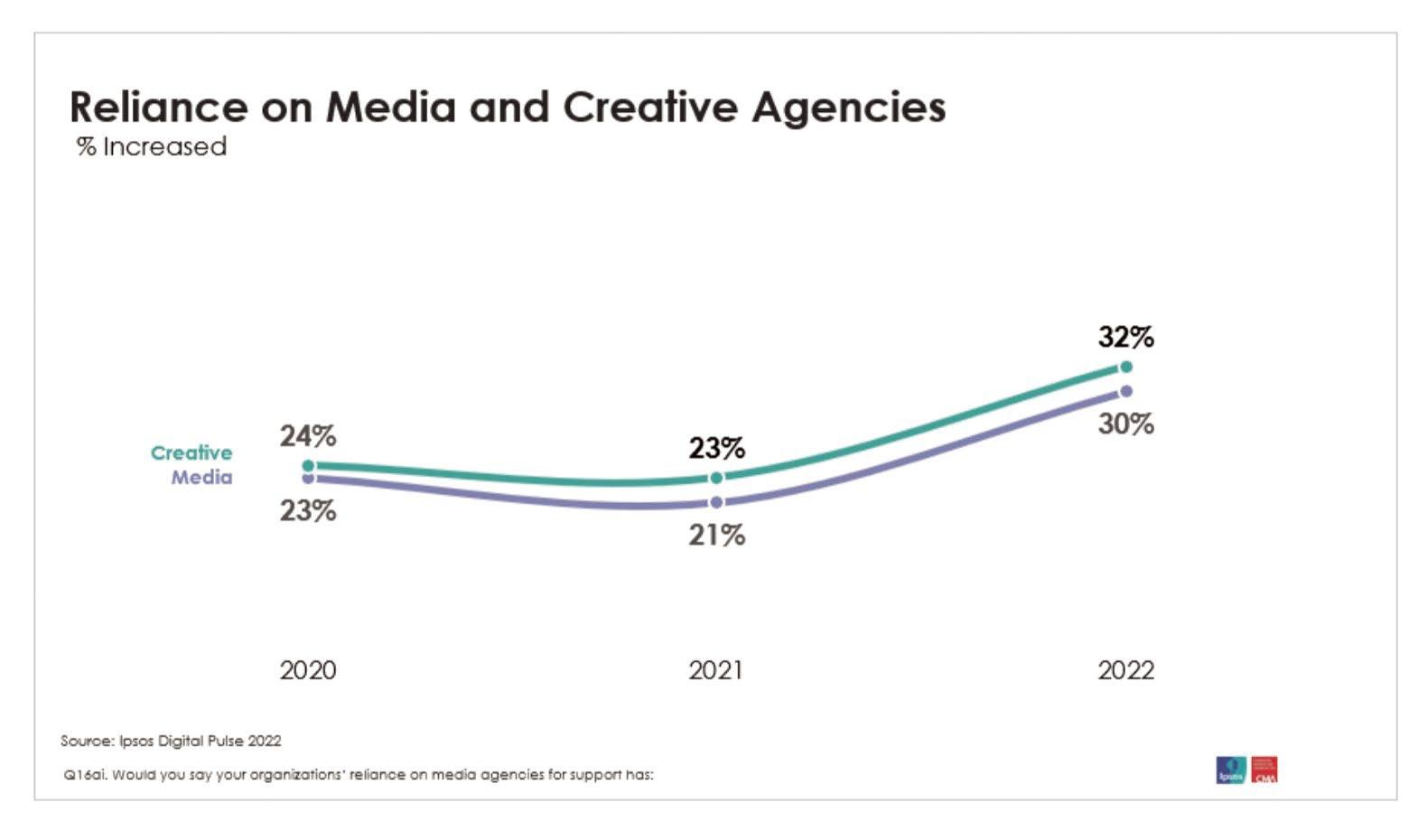
It continues to be the case that some marketers utilize a hybrid agency + in-house model while other marketers outsource entirely for some tactics. For tactics that are either mature, core to one’s business or confidential/sensitive (email marketing, Websites, SEM, SEO and Social) brands take these activities inhouse. In contrast, tactics that are newer and perhaps more innovative they tend to either operate a hybrid model (Branded content/Native Marketing, Influencer Marketing) or outsource the expertise entirely (Augmented Reality and Esports/ Gaming).
Regardless of the degree to which specific tactics are outsourced or kept in-house, most Marketers have faith in their Agencies Digital expertise.

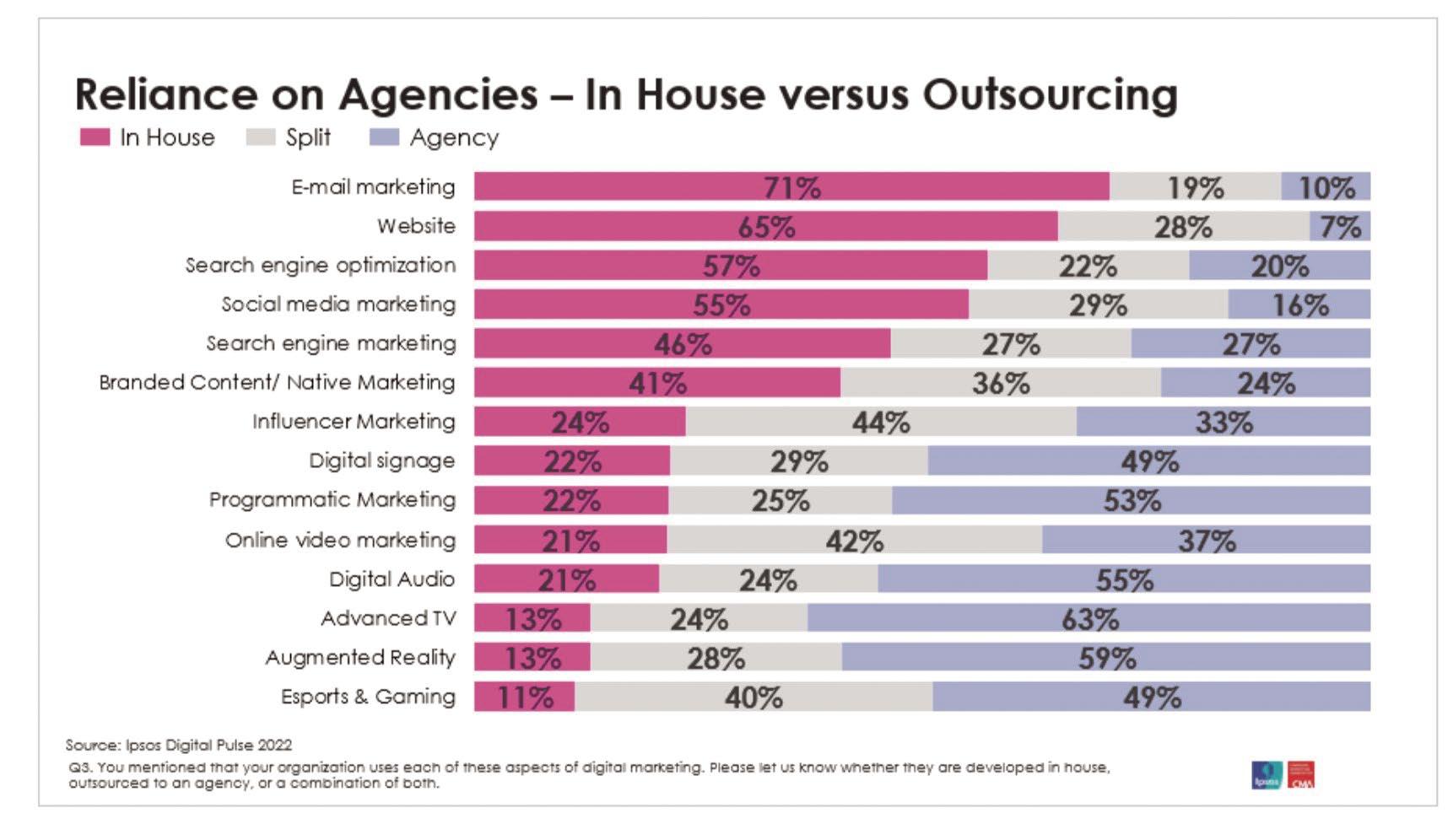
To understand more about these changes and many others from the 16th annual Digital Marketing Pulse Report produced by Ipsos and the Canadian Marketing Association, contact Steve.Levy@ipsos.com. Without doubt this report continues to be the most comprehensive CANADIAN source of information of its kind.
The study uncovers shifts in numerous digital tactics — from the most mature to those that are cutting edge. This deep assessment of the Canadian digital marketing landscape compares and contrasts levels of familiarity and usage of numerous tactics among client-side marketers and agencies. It gauges sentiment on the current and future state of digital marketing, and where appropriate integrates consumer perceptions.
About the author: Originally from the UK, STEVE LEVY has worked in Sales (Xerox UK) and Brand management (Mars UK) before getting into the research business — ACNielsen-Asia, NPD-Canada and Ipsos. Steve has been involved in the Marketing Industry in several roles — Canadian Marketing Association board member and judge for the Young Lions. For the past five years he has been a board member of the Earth Rangers Foundation. He is author of (among other things) the Most Influential Brand study – Globally, the Long Middle and for the past 16 year, The Digital Marketing Pulse. He continues to be a frequent public speaker
// 9 DMN.CA ❰ JANUARY 2023
INSIGHT
3 Ways Data-Driven Marketers Will Prevail in 2023
 BY CAMELA THOMPSON
BY CAMELA THOMPSON
For those of
us
who love trend analysis and data-driven decision-making, the last few years have been rough. From 2010 to 2019, we experienced stability — which lent itself to predictability. Since 2020, we’ve seen the unexpected in politics, shipping and logistics, and pandemics. At the same time, Apple led the charge in privacy-first design, legislation is making data collection increasingly tricky, and a litany of articles claimed that “gut is good enough” when measuring marketing performance.
That last point is an overreaction to B2B’s misconception that everything digital is easily trackable. My favourite mentor convinced me early on that the hard right thing is always more fruitful than the quick easy thing. Although perfect data is a pipe dream, “good enough” insights separate talented creatives from talented creatives who can iterate quickly in a more profitable direction — and that gap is widening daily.
In a market where demand is down, costs are up, and quick wins are virtually non-existent, the people who can channel creativity most cost-effectively will win. And while I can’t tell you which channel will yield the best results next quarter, I can tell you the path the most sought-after talent will take.
They’ll embrace a flexible mindset
Dr. Carol Dweck, the author of Mindset: The New Psychology of Success, wrote, “If parents want to give their children a gift, the best thing they can do is to teach their children to love challenges, be intrigued by mistakes, enjoy effort, and keep on learning.”
My generation was told that girls are bad at math. Rightbrained people weren’t good at left-brained activities. You were
good with numbers, or you were creative. These statements are blatantly false. Unfortunately, many marketers unintentionally perpetuate these myths by saying they “aren’t a numbers person.”
Each of us learns differently. Some of us find that mathematical concepts “click” for us faster than others, but as a culture, we don’t embrace the fact that there are different ways to learn the same concepts. And if we stick with the pursuit, we’ll find a teaching style that “clicks.”
Dweck also wrote, “We like to think of our champions and idols as superheroes who were born different from us. We don’t like to think of them as relatively ordinary people who made themselves extraordinary.”
They’ll develop much needed curriculum
Both sales and marketing are a blend of art and science, but in B2B, sales leaders are known for being more data literate. Marketers, on the other hand, only use data in their decision-making a little over half of the time, according to Forrester.
One-third of the root of this problem is the sheer volume of data marketers produce across dozens of platforms. Stitching it together is complicated.
One-third is an unwillingness to make data-driven marketing a priority backed with an investment in the proper infrastructure and talent to get it done.
The final leg of this threepronged issue is a lack of education opportunities.
We need curriculum to help marketers interpret readily available data. We need standardized metrics across industries for marketers (if sales can figure out what to report on consistently, marketers certainly can if we put our minds to it). But, most of all, we need to learn
how to speak to the shortcomings of our data, establish what is possible, and present our data in a compelling, storytelling format so that executives trust our insights.
A few talented marketers have figured out how to combine numbers and creativity. Let’s capture that knowledge and pass it along in different formats to appeal to different learning styles.
They’ll realize why B2C uses CDPs Customer data platforms (CDPs) connect a business’s core systems and unify that data against the end user or person interacting with your brand. No matter where an interaction or activity is recorded, it appears on a unified timeline for that person. These platforms connect systems and translate data, which means rather than using internal resources to connect and transform data — and then rinse and repeat each time a new tool is added to your stack — the CDP does it for you.
B2B businesses must be able to rely more heavily on their marketing teams, which means business leaders must invest in the right people, and marketers must prioritize getting a grip on their data so they can spot and communicate trends faster.
This also means investors and founders can’t “wing it” regarding their digital presence, and they must prioritize finding the right marketing talent much sooner than they’re accustomed to. The businesses that learn to prioritize their digital customer experience and arm their marketers with good data first will claim more market share.
Marketers who can make the most of data are already in high demand. The increasing pressure to produce evidence that the right investments are being made in marketing is already creating a tipping point that will continue to drive away marketers who want
nothing to do with data.
Those who embrace the trend will be rewarded
In B2C, marketing is a must-have. In 2017, Gartner reported that 75 percent of B2C CMOs owned or were largely responsible for the P&L. In contrast, the B2B startups I’ve encountered prioritize building out their sales teams to hit their goals over investing in marketing. Marketing is seen as “nice to have” because cold prospecting was historically effective. B2B leaders knew that once you sold that one key decision maker, everything else fell into place.
Millennials are flipping this paradigm, and businesses aren’t reacting fast enough. Millennials now make up 73 percent of the buyer committee, and–in huge contrast to Boomers and GenX–Millennials prefer group-think, are highly collaborative, and demand a multi-channel buying experience. To knock this point home, 43 percent of decision-makers would prefer never to deal with a salesperson.
B2B businesses must prioritize hiring marketing leaders as early as possible with a proven track record of building multi-channel digital presences catered to the researching buyer. This also means that marketing leaders must communicate changes in the market and be a louder voice representing the consumer.
This shift in the perceived importance of marketers will generate more lucrative compensation and provide an opportunity for the best marketers to move from influential leaders to visionaries.
CAMELA THOMPSON is the VP of Marketing at CaliberMind, the leading B2B platform for revenue insights you can trust. Based in Seattle, Camela has spent 15+ years in Revenue Operations in the tech industry in successful startups such as Qumulo, Extrahop, and CDK Global.

// 10 ❱ DMN.CA JANUARY 2023
INSIGHT
COURTESY KALHH
8 Predictions for the Year Ahead
BY CONNER GALWAY
1We’re going to have a debate about the ethics of AI in marketing
At the tail end of 2022, OpenAi’s new tool, ChatGPT, sparked a flurry of attention across social media, with people creating funny/amazing screenshots that stretched our imagination about what’s possible with Artificial Intelligence. Now that we’ve become a bit more used to its capabilities, the conversation is going to shift to its ethics. Specifically, we’ll be having heated debates that include some, or more than, the following:
If AI can create a million variants of an ad, then test and iterate it in real time, is that manipulation, or just good advertising?
If AI can write tweets as well — or better than — a human, is it OK to have it run the whole account without telling anyone?
What about chatbots — if they write like humans, do we have to disclose that they’re not?
Is it OK to have AI write all of your work reports for you? If they do, do you have to tell your boss?
If you have AI create a song, who owns the rights?
The education industry is one of the first to grapple with these questions — see how they’re handling it.
2There’s going to be (even more) recommended content on FB & IG
In 2022, Facebook and Instagram
saw their first real competition take a significant chunk out of their market share. In the past, every time that a new startup threatened Meta’s dominance, they simply ripped off its core features and doomed it to second-tier status. This time they haven’t been so successful — Reels is much less popular than TikTok and there’s mounting negative sentiment about the way that Instagram & Facebook serve up content to audiences; However, according to Zuck, they aren’t shying away from an algorithmically-driven future:
“What’s basically going to happen is that, over the next year or two, we’ll start showing more recommended content in the Feed. And we’ll know that we’re doing a good job because the content in the beginning is going to displace some other content, and either displacing that content is going to lead to negative feedback from people, and lead to people connecting with each other less in all the metrics that we focus on, or it will actually lead to people connecting more and being more satisfied with the product.”
Meta’s attempt to become more TikTok-like is going to impact everything from the way we interact with our friends, to the way we think about content marketing. Whether it will be successful or not is very much yet to be determined.
3Facebook is going to launch a Twitter rival “Twitter is in crisis and Meta needs its mojo back” appeared in an internal brainstorm board where Meta leadership was debating how to remain relevant in the current landscape. Both the comments about Twitter and Meta are undoubtedly true, but it remains to be seen whether the world wants another stream-ofconsciousness app. A quote from Casey Newton’s recent article on Platformer seems pretty confident:
“Meta will launch a Twitter feed, probably as a secondary brand. They can’t buy Mastodon, Post News or Parler, so most likely they will build a simple feed that they will keep separate from FB and IG. They will then find a way for folks to import their Twitter social graph into this new app.”

The bottom line is that none of the other platforms can come close to competing with Twitter when it comes to breaking news and other real-time content, so if Meta does make a serious play, we may end up with an alternative to whatever it is that Elon’s up to.
4
VR-based content is coming to your newsfeed
For a company whose demise is being so enthusiastically predicted, there certainly is a lot of talk about what Meta is getting up to this year. That is, perhaps, because it’s one of the only companies that seems to be releasing new products and
features on a regular basis. This one is a double-down on Zuck’s massive bet on his version of the metaverse. Coming soon to Horizon Worlds (Meta’s VR universe) users will be able to capture short clips and images to share directly as Reels.
Whether or not this specific application becomes popular, it seems likely that we’ll start seeing high-quality clips from VR experiences appearing in newsfeeds everywhere very soon.
5
User-friendly AR tools
Perhaps the most underappreciated technology of 2022, Augmented Reality is becoming more user-friendly every day, and the tools to create AR content are about to make creativity much more accessible. We’ve seen various AR tools since as early as 2012, when Yelp launched a map of local businesses that could be viewed through your camera, effectively creating overlays of business listings that appear in real-time in the real world. Since then, other applications have shown up in the form of virtual try-ons (Warby Parker, etc.), semi-real art (Burberry), and enhanced shopping (Walmart), but it’s been only the big brands that have really made use of the technology.
The upcoming release of AR Studio, and other similar tools, will make it almost as easy to create an AR-element as it is to design an IG
// 11 DMN.CA ❰ JANUARY 2023
CONTINUED ON page 15
STRATEGY ISTOCK/ NADEZHDA BURAVLEVA


ShopThing Refines The Omnichannel Experience
 BY MICHAEL BROOKE
BY MICHAEL BROOKE
With so many different ways to market your company’s products and services, it can get overwhelming and confusing. Most businesses want to be everywhere, but in most cases, you can’t be everywhere. It’s critical that you prioritize what channels make sense for your company. For Maggie AdhamiBoynton, co-founder and CEO of ShopThing, a live shopping app, it was all about figuring out where the bulk of their potential users and customers are. “We took three or four ideas and spread them across multiple channels and tried them out. Whatever worked, we leaned heavily on that. Whatever didn’t work, we put it on the back burner to revisit and test at a late date.
Founded in Toronto four years ago, ShopThing combines a number of unique approaches to the omnichannel customer experience. Their app has over 500,000 users who regularly watch fashion influencers explain and examine the latest products — it’s a live shopping experience that is parts eCommerce and part interactive entertainment. Users can ask influencers questions and should a customer see something they like, they can purchase it automatically. ShopThing takes a 20 percent commission on every sale but there are numerous discounts offered.
There are actually two different approaches to the live shopping

// 14 ❱ DMN.CA JANUARY 2023
COURTESY SHOPTHING
Maggie Adhami-Boynton, co-founder and CEO of ShopThing
TECHNOLOGY
COURTESY SHOPTHING
experience. One is based on a scarcity model which offers customers hard-to-find or exclusive items. For example, someone who collects crystal and lives in Denver might not be able to make it to Manhattan, so a live shopper can be truly helpful in answering questions to ensure the correct purchase. The other angle is a curated influencer or expertdriven approach. From the comfort of your home (or any location) you can get an expert who will answer your questions and guide you through your purchase.
Maggie explains that there can be a reluctance to try new channels. “We had focussed most of our efforts on Instagram and Facebook. We were aware of TikTok quite early and so we put up a few videos to test the waters. It literally exploded our business and we went from 10,000 followers on Instagram to 100,000 in one month.”
The one thing about social media platforms is that you have to be constantly vigilant. “Just because Instagram or TikTok is working today for your brand, it doesn’t mean that it will always work,” says Maggie. “It’s crucial that you continually test because consumer behaviour changes rapidly, especially in the digital realm.” It’s important to keep revisiting platforms that may have underperformed initially but could be a great opportunity for growth six months or a year from now.
ShopThing has a staff of about 70 people and they have recently added a whole data discipline unit. Up until then, the company had been collecting a tremendous amount of data, but Maggie admits they weren’t using it in the right way. Maggie meets with the data team on a monthly basis and other departments meet with them on a weekly or bi-weekly basis. “Everyone is filtering in their requests and the data team’s job is to prioritize what makes sense for our business.” One of the major things ShopThing has implemented is OKR - Objectives and Key Results. The critical question that all team members must think about when they are asked to produce data is “does this information drive our objectives forward?”
Many companies recognize that with all these different customer touchpoints, providing all this
feedback can be overwhelming. ShopThing classifies the severity of a problem from 5 which is the least severe to 1 being the most problematic. “We’ve never felt paralyzed to deal with problems because we’ve been able to categorize and prioritize problems” explains Maggie.
The half-a-million users of the ShopThing app have translated into over 22,000 customers. “Nothing makes me happier than to sell things all day and every day” says Maggie. “But we are in this incredible space of commerce and entertainment.” One of their main key performance indicators (KPI) is active users because they know that eventually many of these people will convert to active customers. “If someone only views and never buys on our platform, that’s OK, because I know that ShopThing is also entertainment,” Maggie predicts that within two years, ShopThing will be a full social platform.
Although live shopping is in its infancy in North America, it is over a $400 billion business in Asia (primarily China). “The reason for this is that the Asian consumer is different from what you find here” explains Maggie. “Consumers in Asia use technology in a completely different way — they are about five to ten years ahead of us and utilize things called super apps.” Sixty percent of the shopping done in China is now done with live shopping. While the Chinese version of Google is the most visited site, the second most visited is a live shopping site.
Maggie believes that live shopping will become increasingly popular but doubts that it will ever reach the levels found in Asia. “ShopThing made a conscientious decision to take the best of what was happening with live shopping apps found in Asia and tailored them to the North American consumer.”
The conversion numbers of regular eCommerce compared to live shopping are quite extraordinary. According to the most recent data, conversion rates are 5 to 10 times higher with live shopping. “Our influencers genuinely endorse products they believe in and this has a tremendous impact on people’s decision to buy,” says Maggie.
8 Predictions for the Year Ahead
CONTINUED FROM page 11
post in Canva. When it comes to emerging technology, sometimes it just takes a bit of user-friendliness to spark a creative surge, and it seems that we may just be on the crest of that wave.
6The “Free Speech” platforms will either fail, or become non-profits “You cannot reasonably expect to collect any meaningful advertising revenue if you do not promise those advertisers ‘brand safety.’ That means you have to ban racism, sexism, transphobia, and all kinds of other speech that is totally legal in the United States but reveals people to be total assholes. So you can make all the promises about ‘free speech’ you want, but the dull reality is that you still have to ban a bunch of legal speech if you want to make money.” — Nilay Patel
Much has been made of the free speech debate on social media platforms. Wherever you come down, one thing has been proven: Unmoderated social media is bad for business. Rumble, Parler, Gab, Gettr, and more alternatives have made a lot of noise with their launches, but there’s one thing that none of them have been able to make: Money. Unregulated platforms are dangerous places for brands to be, and it’s therefore very difficult to attract advertising dollars. Instead, it seems pretty clear that the future of for-profit social media sites is going to include a certain level of moderation and house rules.
The alternative, of course, is to follow the Wikipedia model — operating as a public good, accountable to no shareholders or market forces. There are examples of that model working already: Messaging app Signal and opensource social media site Mastodon are alive and well, but because they don’t have profits to report, they also don’t have incentive to invest in things like hyper-growth or advertising campaigns.
Expect to see a slow and steady movement to non-profit social media outlets for those who seek them out, but their growth certainly shouldn’t be seen as a threat to the big incumbents.
7
Linkedin will become increasingly more relevant
There are two major forces driving this one: First, as we know, layoffs and other tough economic times mean that more people will be looking to boost their digital resumes, which of course happens on LinkedIn.
The second one is less datadriven, but is about the types of interactions that people are looking for online. There is a sense of fatigue about what goes on in the replies on Instagram, Twitter, YouTube, and other social platforms. For the most part, Linkedin is a much more positive place, where people generally share messages of support and encouragement. While it’s far from perfect, the desire for non-toxic interactions may be driving some of the growth that Linkedin has been seeing recently.
8
Live-stream shopping is coming, especially on TikTok
For the past several years we’ve been hearing reports of Billions of dollars of sales happening via live streamed shopping experiences in Asia, but the behaviour just hasn’t been adopted the same way in North America. That may be changing as TikTok becomes more universally adopted. TikTok has all of the tools and experience necessary to provide a best-inclass experience, while at the same time, millions of North Americans have become accustomed to live streaming in general via platforms like Twitch and YouTube.
Watch for TikTok’s Creator Fund and other revenue-sharing efforts to support its live streaming effort because, when it comes to marketing content, trends tend to follow the money.
CONNER GALWAY is the Founder of Junction Consulting, a digital consulting firm that specializes in tourism and hospitality. He’s also the President of eLearningU, North America’s largest learning platform for tourism marketing, author of The Brief, an award-winning digital business newsletter, and the most recent recipient of Marketing News Canada’s Leadership Award.
// 15 DMN.CA ❰ JANUARY 2023
TECHNOLOGY
How AI is Revolutionizing the Fulfillment Process
BY MICHAEL BROOKE
When it comes to fulfillment and delivery, artificial intelligence (AI) is being used to create a number of significant benefits. This includes expanding route optimization and asset management across networks, for all stakeholders. AI can be use to optimize fleets to eliminate bottlenecks, reduce empty runs and improve asset utilization
It’s also vitally important when it comes to responding more quickly and accurately to fluctuating supply and demand — this especially true when it comes to providing excellent customer service.
The technology is also reducing cargo delays and overall dwell time while maximizing output to the port’s logistics hub. Overall, thanks to the power of AI, a more fluid, predictable supply chain is created that’s easier to track compared to conventional methods.
AI can be used to analyze customer data and predict which products will be most popular in a particular location, allowing companies to stock their fulfillment centers accordingly. AI can also be used to optimize routes for delivery drivers, helping to reduce costs and improve efficiency.
Emerging disruptors in the fulfillment and delivery space are also using AI to innovate and differentiate themselves from traditional players. For example, companies like Deliveroo and JustEat are using AI to optimize the delivery process, from routing to dispatch to customer service. These companies are leveraging their data and technology to offer a more seamless and efficient delivery experience, which is helping them to gain a competitive advantage over traditional players.
In Canada, freight forwarding is a 16.7 billion dollar market with a number of major players who for decades were content with phone calls and faxes. In 2013, a company called Flexport entered into the market.
The company was founded by
Ryan Peterson and in an interview with Daz Rush of the a16Z podcast, he stated the following: “I knew what the customer experience should be. I wanted this dashboard to give me visibility over all my freight, tell me what it was going to cost, when things were going to arrive, what all these weird terms mean. The industry still uses Viking English. We say bill of lading, instead of loading.”
Peterson says that when they started, he wanted to create a simple dashboard — something like Turbo Tax for importing. The company analyzes data from millions of shipments to identify trends and inefficiencies in the supply chain. As a result, Flexport can offer customers greater efficiency and less expensive shipping routes. The data also gives clients useful insights into the global supply chain. When it comes to streamlining the shipping process, Flexport allows customers to track their shipments and manage customs paperwork in real-time.
In terms of incorporating AI into fulfillment,Chicago based 3PL provider ShipBob uses a number of workflows that aim to automate processes and reduce the need for fulfillment associates to make decisions on their own.
Kristina Lopienski, Director of Marketing Communications explains that ShipBob routes each order to the fulfillment center closest to that order’s destination, finding the closest (fastest) and most cost-effective warehouse and shipping option each time.
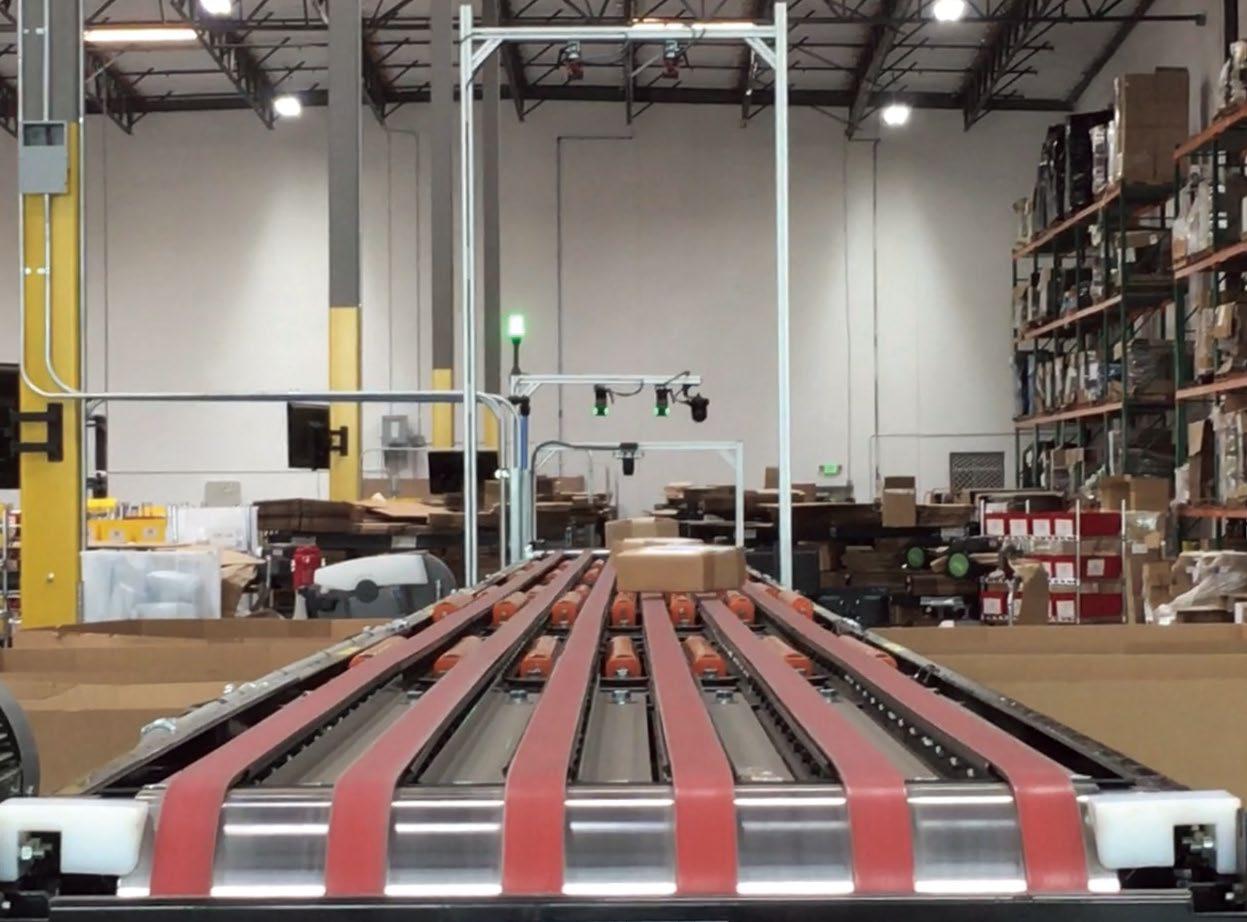
“We use a box selection algorithm to ensure orders have consistency in shipping costs by calculating the ideal package size for a given order combination.”
Their Cubiscan machines determine the right size depending on the dimensions and weights of each product, while also taking each customer’s packaging preferences into account to tell them which package type and size they should
use for any order combination. “This means we select the best suitable packaging while reducing dimensional weight” says Kristina.
ShipBob’s sorting machines are connected to their proprietary Warehouse Management System and scan every single package after they are labeled and are on the conveyor belt. The scan validates the weight/dimensions of each order and routes them to the correct carrier sort lane to be ready for pickup at the shipping service level.
The analytics provided to merchants includes an Ideal Distribution tool to help merchants get a better understanding of which fulfillment center locations they would benefit from, based on historical order data. It compares their current versus ideal inventory distribution, and forecasts how costs, shipping zones, and transit times would shift by changing to the recommended regions.
When it comes to investing in the future of AI, over 300 Canadian companies are looking to Montreal-based Scale AI. They are one of Canada’s five innovation superclusters, created to advance the Canadian AI innovation ecosystem. They offer funding, expert guidance and a community of like-minded peers. Scale AI is investing in Canadian companies across a range of industries that are utilizing AI to enhance their supply chain. Since its inception, they have invested over $300 million.
Scale AI offers companies a number of different membership levels. They will connect members with financial, technical and educational resources, as
well as peer support, focused on artificial intelligence and intellectual property expertise, all engineered to help them scale their organization, their partnerships and their potential.
The Port of Montreal worked with Scale AI on a project with the objective to reduce container dwell times for critical cargo by 50 per cent. They developed a logistics tool called CargO2ai with a humanitarian focus. The tool was specifically created to deal with the COVID-s19 pandemic and ensure swift delivery and fulfillment of medical and safety supplies.
CargO2ai uses AI to quickly identify and prioritize the critical cargo that Canadians need to avoid supply delays and stock shortages during precarious economic and public health situations.
When it comes to humanitarian purposes, the Port of Montreal and its partners have processed 5,800 critical-cargo containers. The project has improved communications between all stakeholders and has reaped tremendous benefits. Daniel Olivier, the director of business intelligence and innovation with the Montreal Port Authority spearheaded the move to using AI. As he explains, “I used to receive the cargo manifest 24 or 48 hours out. Now I get it up to 10 days out — in some cases as early as the vessel leaving Europe. Olivier states that the Port of Montreal has been able to significantly improve the timeliness of the reception of the data. This has made things much better for the Port from a planning perspective — from railcards, to trucks to labour.
// 16 ❱ DMN.CA JANUARY 2023
TECHNOLOGY
ShipBob utilizes AI to automate processes and reduce the need for fulfillment associates to make decisions on their own.
COURTESY SHIPBOB
Should You Build or Buy a Channel Incentives Platform?
BY 360INSIGHTS
Channel incentive platforms are now a staple of the sales process, whether vendor organizations are ready for them or not. As indirect sales become a critical component to reach business growth goals, your company will be faced with a tough question: Is it more effective to build or buy a channel incentives management platform?
For most, the answer is not “if” to replace a legacy incentives process with an automated platform, but how. This is where the build vs. buy dilemma takes center stage. To find a solution, it’s important to look at the key considerations of the build vs. buy argument.
How much will it cost to build vs. buy a channel incentives management platform?

Cost is always a major consideration, but it’s one that doesn’t fit neatly into the pro or con perspective. All sales incentive platforms come with a price tag with a tradeoff of less overhead spent on development.
For most vendors, it comes down to the initial cost to purchase a SaaS solution compared to the overall cost of man hours needed for professional developers to write the code in-house. Larger businesses with in-house software development teams may be able to efficiently create channel solutions that are custom built to their specific needs without having to outsource automation. But this usually means hiring expert developers or sacrificing other technology priorities as resources get reassigned.
There are also costs associated with lost business over the course of the years it takes to build and launch a platform. According to Deloitte, the decision itself takes anywhere from 3-9 months, and if deciding to build, that number increases by years, not months. Hidden costs due to development
delays can also result in negative customer feedback or even lost revenue. This is in addition to ongoing maintenance, security costs, and a hefty data storage bill, while these costs are typically included in the price of buying SaaS software.
If you know it will take more time and money to build an incentives platform in-house without a necessary guarantee of improved productivity and ROI, you already have your answer. But if cost alone doesn’t provide a clear path forward, there are other factors you can consider in the debate.
What are the pros and cons of buying a channel management platform?
There several reasons the SaaS model is defeating traditional sales incentive approaches:
❯ Predictability – SaaS reduces the burden of up-front and longterm cost with a predictable, distributed fee-based model that can be spread evenly throughout the year.
❯ Scalability – SaaS allows providers to easily upgrade and downgrade solutions based on needs, and users can be added or removed as needed.
❯ Growth – Upgrades, support, and on-going maintenance are outsourced, leaving internal teams time to focus on running the business, building programs to address partner needs, and creating new growth opportunities.
❯
Speed – Even SaaS models that don’t completely run “out of the box” and need to be further customized can save time in development and time to market, allowing for faster partner enablement.
❯ Expertise – Channel software providers deliver soft benefits like understanding where new features should be added based on collective feedback from
other users of their platform.
❯ Security – Obtaining security certifications such as ISO27001, ISO9001, SOC 1, and SOC 2 for custom-built solutions is time consuming, whereas modern SaaS platforms are architected with security by design.
❯ Compliance – From QA testing and troubleshooting, upgrades or maintenance, and bug fixes, SaaS offers maintenance and compliance with built-in frameworks for data regulations like GDPR.
Of course, the SaaS model has its limitations, which means vendors who need customized solutions may struggle to optimize their purchased software. The need for personalization favors the build model in a few ways:
❯ Control – Full governance over data and associated requirements.
❯ Customization – Designing a custom platform to fit your specific needs
❯ Collaboration – Custombuilt software solutions offer capabilities to better engage partners, allowing them to be in frequent collaboration and help grow the business.
❯
Single vendor – Adding more SaaS vendors can cause ecosystem overload, whereas building gives a single-vendor view, if the systems aren’t siloed.
❯ Integration – Deeply integrated solutions can be a competitive advantage if developed, deployed, and maintained correctly.
If costs aren’t an immediate
decision-maker, then your business likely has channel management needs that go beyond the basics, and you need a level of customization, flexibility, and scalability you haven’t found in many SaaS solutions. In which case, you will need to consider timing, scalability, and level of support offered through a SaaS provider compared to your in-house capabilities.
How do you settle the build vs. buy debate?
Unless you have a team of developers who can support a custom-built solution, the ideal outcome is to find a single-vendor SaaS channel incentives management platform that offers the benefits of a personalized and collaborative ecosystem. SaaS providers with strong ecosystems use incentives across the collective parts of the deal to deliver more value for influencers, referrals, MSPs, ISVs, partners etc. Investing in solutions that help manage these capabilities, activities, and data supports the channel partner journey, and can result in greater success.
To answer the build vs. buy question, first look for automated solutions that enable you to run all your partner programs and promotions from a single platform with features that are adaptable, customizable, and scalable to support your unique business needs.
360INSIGHTS.COM make the science of motivation and the management of spend easy so businesses can build stronger relationships with their partners.
// 17 DMN.CA ❰ JANUARY 2023
INSIGHT COURTESY 360INSIGHTS
The Myths and Realities of Social Intelligence and Analytics

// 18 ❱ DMN.CA JANUARY 2023 KICKER
FEODORA CHIOSEA
ISTOCK/
BY LEENDERT DE VOOGD
hile social intelligence is a growing space, there are still plenty of misconceptions about what it is and how it works.
At the start of 2022, Synthesio deemed this year the “year of AICI.” In many ways, this was true: we saw an increasing number of clients embrace combining online and offline data sources (like social + survey or search), and social listening “grew up” even more. The value of social data continued to move beyond social marketing teams to empower insights, brand, and even innovation pros. And companies allocated more budget to social data: The Social Intelligence Lab reported in its State of Social Listening 2022 report that 33.5 percent are spending $100K or more on social data tools every year (up from 10 percent in 2019).
But despite social intelligence’s growth, we still hear a lot of misconceptions about what it is and how best to use it. So to wrap up 2022, we’d like to dispel some of the most commonly occurring myths:
‘Social media data is worthless – it is all Twitter data and it doesn’t tell me anything’ Reality: Twitter data can sometimes dominate results, if you allow it to. And sometimes it’s very useful for brands; even the microblogging, short and sweet text has value in it, especially in its volume. But Twitter data isn’t right for every single question or approach. Just as you would consider how to build a good sample in a qualitative or quantitative research project, it is important to consider your “data universe” when gathering social media data. You need to access a wide variety of sources in your chosen platform before launching a social media research program. On several occasions, specialized blogs and forums are more insightful than Twitter (for example, healthcare/pharma companies might get more out of Reddit health communities or dedicated forums like MedHelp).
WIt is also critical to treat the data coming from various sources as a heterogeneous mass. A tweet about “Tesla” for instance will carry a very different meaning layer compared to a “Tesla” usage experience review or a “Tesla” post in a forum on the future of mobility. This is where experienced analysts come in: they can bring this data to life, pretty much in the same way we’d split and report our survey data comparing target groups, socioeconomic or attitudinal criteria.
‘Social intelligence is only for understanding
PR and social media marketing efforts and to manage crises’
Reality: Social media data and intelligence can be useful in those cases, but there are so many more questions that it can help with. We have used it reliably in many cases, including to guide and supplement segmentation and audience understanding; to understand a market landscape and broader context; to understand signals of macro trends and deep dive into micro- and nano-trends; to surface insight about why people engage (or not) with particular products and services; to understand specific brand moments that comprise a brand experience; and to get a clear picture of what makes people tick and what ticks them off on a wide range of topics. This is by no means an exhaustive list, but these are approaches we’ve taken time and again to create actionable insights.
‘One can just look for what’s interesting within all social media data’
Reality: Given enough time and money, you might eventually get there (while also burning an incredible amount of electricity), but resources are rarely unlimited. As the saying goes: “If one does not know to which port one is sailing, no wind is favourable.” Therefore, it is critical to create some boundaries around your research, so that you know you’ve found something interesting. Your
human expertise and industry knowledge will help you to develop some relevant boundaries.
‘No one talks about this very specific topic and, therefore, social intelligence cannot help with research I can’t do any research using social intelligence Reality: Sometimes, we can be a little too specific in our requirements. This is not uncommon with brand research. It does not mean that there is no value that social media data can provide – in fact it can help steep us more in the consumer reality. Consumers might not talk about a specific brand’s product – for example a specific brand of frozen peas or tinned tomatoes – but they will talk about very relevant topics, such as how they cook at home, favourite flavours and dishes, and what they aspire to bring to their mealtimes.
‘Social intelligence is fast and cheap’ Reality: It can be faster and cheaper than more traditional methodologies for sure. It can also give you deeper insight into what is moving people because it is unprompted. And advances in AI, like our Topic Modeling, are making the path from data to insights even shorter. But because there are layers of refinement needed to prepare a strong and relevant dataset as well as humanled insight, good social intelligence and analytics requires a certain level of investment.
‘AI does it all‘ Reality: Analysis of any unstructured data would be incredibly restricted without AI. In the first place, it would be nearly impossible to find the data we wanted to review. The power we have as human beings is to be able to find meaning and importance in the factors that AI brings to our attention. AI is powerful and can show us patterns we might not have noticed ourselves. But it takes a human being to say why that is important, assuming it is a
human being who understands the question and the broader category and topic. Setting expectations around AI is a key tip we heard from our customers in our panel on scaling social intelligence.
‘All tools are created equal’ Reality: Each tool has its pros and cons and there are always tradeoffs depending on what you want to do. There are many different factors to consider, depending on what’s most important to you and your organization – data sourcing, level of cleaning, ease of use, built-in widgets, volume of data, level of in-built analytics and AI, language and geographic coverage, etc. What’s more, these are changing all of the time. It can feel overwhelming to stay on top of it, but regular reviews of needs versus what you can get are important.
‘It is very easy to become an expert in social intelligence’ Reality: Like any research approach, a little knowledge can be dangerous. You cannot become an expert in all aspects of social intelligence and analytics. But it is possible for a keen and curious mind to learn how to make the most of unstructured data and how to execute worthwhile and reliable social media data research and insight.
It’s also increasingly accessible (and important) for non-experts to use insights from social data in their daily jobs. Some of our clients have set up self-service dashboards for their peers to view key metrics, or do a quick check on what consumers are saying about a particular topic. Others have linked social listening KPIs to their sales metrics and other business KPIs.
But social intelligence requires research rigor (especially when analyzing multiple data sources or applying predictive models!) which is why many of our clients opt for a hybrid approach, combining SaaS technology with expert services.
LEENDERT DE VOOGD Global Service Line Leader, Social Intelligence Analytics Ipsos.com

// 19 DMN.CA ❰ JANUARY 2023
Myth 1 Myth 5 Myth 3 Myth 7 Myth 6 Myth 4 Myth 8 2 Myth INSIGHT
A Double-Take: Digital Twins and Customer Experience (CX)
BY STEVE ZISK
Your primary care provider calls you to let you know to stop taking a recently prescribed medication because it causes a reaction when paired with another medication you’re taking. A hotel provides you with a virtual tour on a mobile app to let you choose which room to reserve. When you head to the water park, the app guides you to a vacant chaise lounge that meets your preferences for shade and proximity to a lifeguard station. At a wholesale grocery store, an associate finds an item you’re looking for by scanning the entire warehouse — all while standing by your side.
Once a niche technology in engineering and manufacturing, digital twins are taking industries by storm, and the real-world examples above from healthcare, hospitality and retail demonstrate how digital twins are increasingly being used to enhance customer experience.
A Mirror Image:
Digital Twins and IoT Gartner defines a digital twin as a digital representation of a real-world entity or system, with implementation of the entity or system as an “encapsulated software object or model that mirrors a unique physical object, process, organization, person or other abstraction.”
As a concept, digital twinning originated as a method to test and monitor a physical object without having close proximity to it — think rocket ships. In its infancy, use cases were mostly tied to building and testing engines
and other complex physical objects. Soon enough, digital twins expanded to entire factory floors, supply chains, city grids and other processes and systems, used mainly to identity existing or future problems with the nondigital object or system, such as predicting engine failure.
There is often an Internet of Things (IoT) component, with sensors connecting the physical and digital objects and providing a virtual representation. A classic example might be multiple pieces of equipment on an assembly line, where sensors on the machinery connect to a visual model that identifies potential fail points. IoT devices also represent several familiar customer experience use cases, such as a smart thermostat or a connected appliance that adjust to a customer’s preferences. Using sensors to create a virtual model of real-time inventory might enhance a personalized customer experience by helping a customer fill an online shopping cart based on availability at their favourite location.
Predictive Digital Twins
A predictive digital twin takes the concept a step further and allows digital twins to not just measure but also predict realworld behaviors. Once a digital representation of a real-world entity or system has collected enough sensor data, it might then be programmed to predict how the measured system will react or respond to external forces or situations. A healthcare provider advising you on medication adherence is not, for example,

referencing an actual digital model of your body but a statistical model based on past experience.
Similarly, a virtual downtown traffic grid, fed enough data, might predict high volume patterns which are then used by your hotel the night before your check-in to notify you of the shortest route from the airport at the anticipated check-in time.
Another digital twinning use case for enhancing customer experience combines a digital model with an interactive component. One example is a virtual dressing room, where an augmented reality (AR) app allows a customer to virtually try on items before purchase. Similarly, a customer might “place” a digital representation of a piece of furniture in their living room, seeing for example whether a couch will fit in a certain corner, or how the fabric matches the paint colour.
Digital models can even encompass machine learning models. Using sensors in a store, a brand might collect traffic patterns for an extended period of time. Once data is gathered and the model trained, a machine learning model can run simulations with a goal of optimizing floor layout on a store-by-store basis. Similarly, a model might use a digital representation of an audience to analyze or predict a propensity to purchase, product affinity, likelihood to churn or another business metric. By feeding the results of how an actual audience behaves into the digital model, a brand closes the testing loop and improves the accuracy of the predictive digital twin. Conceptually, a digital model
of a customer might represent a composite of real-world behavior with what’s happening in the virtual model, providing a brand with an even more detailed roadmap or insight into customer journeys.
Still a relatively new concept, first gaining widespread recognition about 20 years ago, the use of digital twins is quickly making inroads in customer experience across all verticals. Gartner recently predicted that digital twins of customers have the potential to transform how enterprises deliver experiences by simulating and anticipating customer behavior, much like how engineers first used them for predictive maintenance.
Redpoint is a firm believer that delivering a real-time, omnichannel personalized customer experience requires matching the cadence of a customer as a customer journey unfolds. At its core, the use of digital twins in customer experience is all about staying close to a customer without encroaching on their experience — being relevant but not creepy. A digital representation of a customer that models close proximity adds another tool to a marketer’s arsenal, helping a brand to deliver memorable moments that resonate with customers.
STEVE ZISK is a seasoned technology professional with more than 35 years of expertise in software engineering and product marketing. As senior product marketing manager at Redpoint Global, Steve is tasked with developing messaging and marketplace positioning for Redpoint’s customer engagement platforms.

// 20 ❱ DMN.CA JANUARY 2023
TECHNOLOGY
DEVRIMB
ISTOCK/


















Resource Directory // 21 Your Source For Premium Email & Phone Appending Grow & Enhance your Direct Mail Lists with: Data Appending Mailing Lists Email Appends: Grow your list by 40% Phone Appends: Boost telemarketing lists Free Match Test: See how many we can add Consumer & Business Records: U.S. & Canada NCOA Sales Leads 1-800-MELISSA MelissaDirect.com LIST SERVICES LIST SERVICES BETTER DATA FRom CANADA’S LEADER iN CoNTACT DATA SoLu TioNS Ask for a FREE EvALuATioN and pricing! 1-800-454-0223 sales@cleanlist.ca cleanlist.ca ) an interact direct company Date: July 4, 2013 Client: Cleanlist.ca Docket: 3540 Application: Print, 4x4.325", 4C AD: Carter AM: Sinclair Version: F6 Media: Direct Marketing Magazine PLEASE NOTE This file has been optimized for its intended application only. For uses other than intended please contact Seed for alternate formats. Data Cleaning • Address Correction • Mover Update • Deceased Identification Data Enhancement • Phone Append • Demographics Prospect Databases • ResponseCanada • Consumers, Movers and Businesses Custom Solutions CL_ResourceAd_4x4.325_v04.indd 1 DATA ANALYTICS SoapStix Portable Soap Spray Wash Hands... Anywhere! Toothbrush Caddy Hygiene Dental Care Fanatic FAN Souvenir Pennant How to Increase Fundraising with Unique Functional Products Make a lasting impression with these great promotional incentives. When planning your next fundraising event or function look at adding some timely products with your message and sponsor that will have much greater impact with everyone. For more information contact: promotional@stixbrandsinternational.com To advertise in DM Magazine Resource Directory Contact: Steve Lloyd, steve@dmn.ca
Recognition is Critical
BY JOHN TSCHOHL
Irecently asked a friend how often, during her career, she had been complimented or recognized for her work. Her response? “Not often enough.”
Unfortunately, that is true for most employees. I wonder why that is. I have some ideas that I’ll share with you here. The first is denial. Most managers and supervisors think, “I pay Charlie a lot of money to do what he does for the company. Why would I also have to praise him and recognize him for doing what I pay him to do?”
That fact is that money will get employees through the doors of your business, but it won’t keep them there. What will?
Recognition. Praise. Feeling valued. Let’s face it, most managers and supervisors have had no training in how to effectively recognize employees. Many were simply promoted to their positions without being provided the training necessary to interact with — and motivate — employees.
I’ve found that the most intelligent people often are the worst when it comes to soft skills. They have a hard time getting out
of their own heads and verbalizing what they need others to hear. They don’t realize that you can’t take employees for granted. You have to let them know you value them and what they do for you.
In order to be effective, recognition must be genuine, specific, sincere, and timely. It’s not enough to recognize employees and their contributions to the company once a year during their performance reviews. It’s also not enough to simply say, “Alice, you did a great job.” Tell her what job you are referring to, be specific about what she did that impressed you, and let her know how proud you are of her and her work.
It’s also important that you recognize employees in front of their coworkers. Doing so not only increases the pride those employees feel at being singled out and complimented, it motivates other employees to do well and also be recognized.

You can take that a step further and recognize employees in front of customers. For example, you’re walking the floor and notice Allan assisting a customer. You might stop, introduce yourself to the
customer, and say, “Allan is one of our best employees. I know he’ll do a great job in taking care of you.”
One of the great things about using recognition as a motivator is that is doesn’t cost you anything. It fact, it actually saves you money by reducing employee turnover and the costs associated with hiring and training new employees to replace the ones you lost.
If you want to give someone a raise, you have to get approval from others to do so. But, if you want to recognize them, it costs nothing so no approval is necessary. You are free to reward employees with your words and build a team that works well together and that will drive your business. If an NFL coach doesn’t motivate his players to work together as a team and win games, that coach will be fired.
My research shows that, given a choice of $100 or a complimentary note written on a manager’s personal stationary, most employees will choose the note. Why? Because, once they spend that $100, it’s gone. But a handwritten note is personal and lasting. I have a friend who has
saved such notes over the course of her career. She keeps them in a file and reads through them once a year to remind herself that what she does is appreciated.
Now, I must say this: There are some employees who simply cannot be motivated, no matter what you do. Although they physically show up every day, they have mentally left you. Ford Motor Company announced a few months ago that it is giving its white-collar employees, who have been identified as underperformers, the option to leave and take a severance package or enroll n a performance enhancement program. Employees who choose the enhancement program but whose performance doesn’t improve will be terminated with no severance package.
Ford Motor Company realizes what too many companies don’t: If you’ve tried everything you can to recognize and motivate employees — and nothing changes — cut your losses, and let them go.
For more information on JOHN TSCHOHL and the Service Quality Institute, visit www.customer-service.com

// 22 ❱ DMN.CA JANUARY 2023
LEADERSHIP
ISTOCK/ DRAZEN ZIGIC









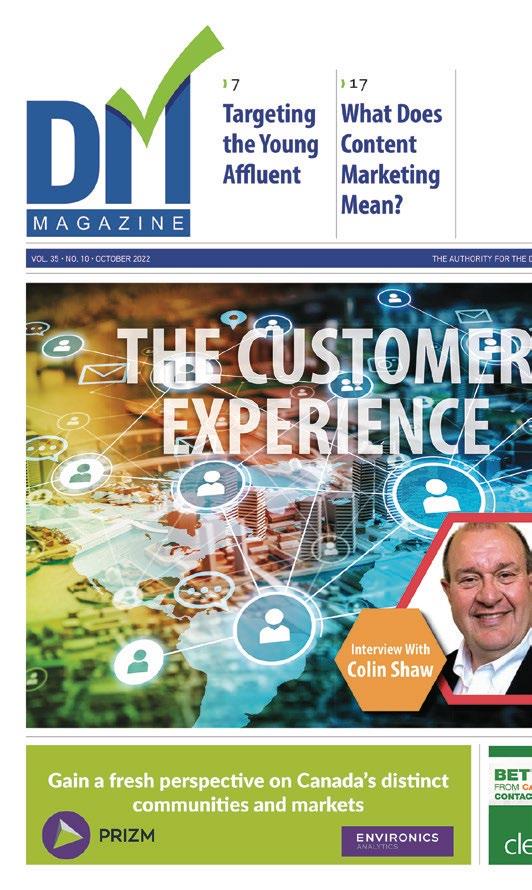














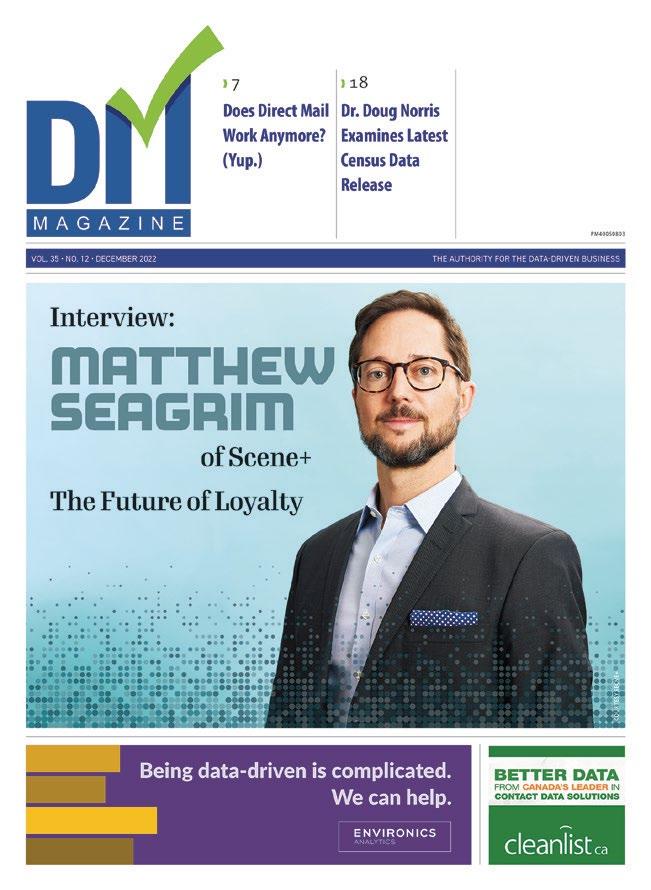


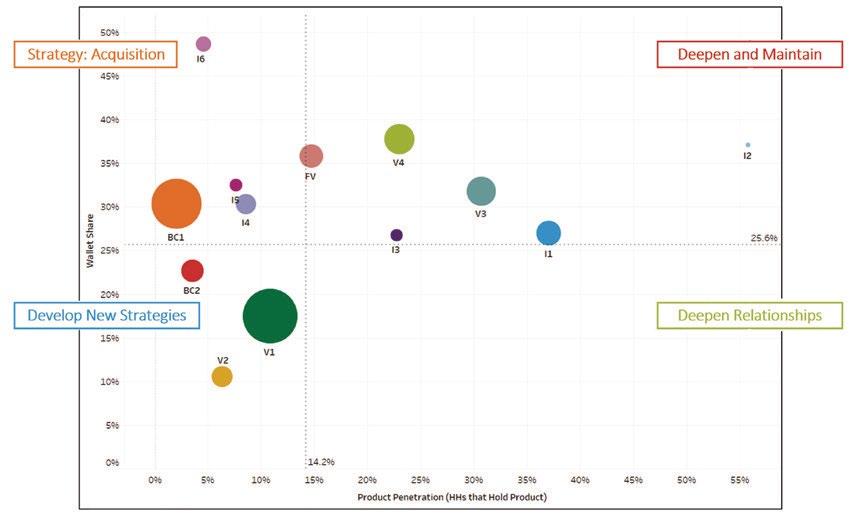




EA’s ever-growing network of over 50 activation partners includes adtech platforms, media agencies, publishers, broadcasters, list providers and distribution companies to ensure you can use our data for analysis and then reach your target audience. Media Activation Print Radio Direct Linear & Connected TV SMS Email Social Media Out of Home Digital OOH Mobile Desktop Comprehensive, updated financial metrics on Canadians. Understand who is most stretched to make ends meet, who is affected by property market conditions and who has money to donate to their favourite charities. Finances Deposits by Region: Penetration vs. Wallet Share Product Penetration (HHs that Hold Product) Wallet Share Deepen Relationships Deepen and Maintain Strategy: Acquisition Develop New Strategies Environmental concern, privacy, trust and social connectedness. Psychographic indicators have shifted and Canadians’ social circumstances have changed. It’s never been more important to look at these indicators and map them to different populations. Attitudes, Mindsets, Social Vulnerability Index | Social Vulnerability 124 SOCIAL VULNERABILITY INDEX* 49.1% Index:188 Household Size -1 Person 11.7% Index:117 Unemployment Rate 91 Index Community Involvement 14.9% Index:197 Perceived mental health is fair or poor 51.5% Index:118 "You cannot be too careful in dealing with people" 24.6% Index:235 People know well enough to ask favour (none) 34.7% Index:156 Close relatives (0-2) 47.1% Index:110 Close relatives in same city (0-2) 33.4% Index:124 Close friends (0-2) 29.9% Index:107 Close friends in same city (0-2) EA’s ground-breaking mobile movement and web behaviour databases not only help you keep track of the “clicks versus bricks”, but know which Canadians are driving these trends nationally and locally as those behaviours change. Online & Offline Habits March 22 March 21 August 20 Ratio of Website Visitors to In-Store Visits January February March April May June July August September October November December January February March April May June July August September October November December January February March April May June July August September October November December January February March 2019 2020 2021 2022 0.0 1.0 2.0 3.0 4.0 5.0 6.0 1.9 1.0 2.0 4.7 Retailer B Retailer A With an aging population, increased immigration, relocation and changing commuter habits, our suite of demographic products help you stay on top of the changes – nationally, by neighbourhood, and everywhere in between.
Demographics Dominant Country of Origin China, People’s Republic of India Nigeria Toronto CSD by Dissemination Area
data
your
Contact us
segmentation
you
our data
activation
data-driven is
We can
Looking to achieve the results that data promises? Ask EA. For your free PRIZM consultation, contact us at: https://www.environicsanalytics.com/dm-mag
Changing
Harnessing
across
organization to be truly data-driven is not easy.
to learn more about how our PRIZM™
system helps
connect
to
for campaigns that drive real results. Being
complicated.
help.









































































 BY CAMELA THOMPSON
BY CAMELA THOMPSON



 BY MICHAEL BROOKE
BY MICHAEL BROOKE























































